Basically mig welding liner is a tube that guides the wire from wire feeder to the mig gun contact tip. It is a conduit that connects the mig tips to the wire feeder. This essential component plays a key role in improving your mig welding performance.
So, without more chit-chat, let’s get into the details of it along with my some best selections on the MIG liner.
Lists Of Best Mig Wire Liners
- Lincoln Mig Gun Liner (Best Overall)
- Welding City Steel Liner (Best Stainless Steel Liner)
- Miller Welding Cable Liner (Best For Beginners)
- Hobart 196139 Liner (Editors Choice)
- Tweco 1420-1113 Conduit Liner (Best For Universality)
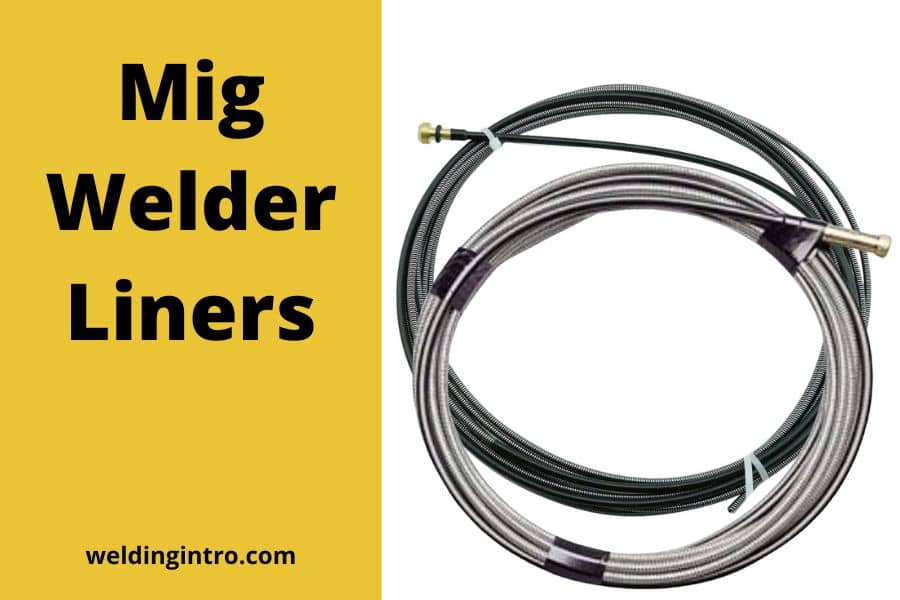
#1 Lincoln Mig Gun Liner Kp1937-3 (Best Mig Liner)
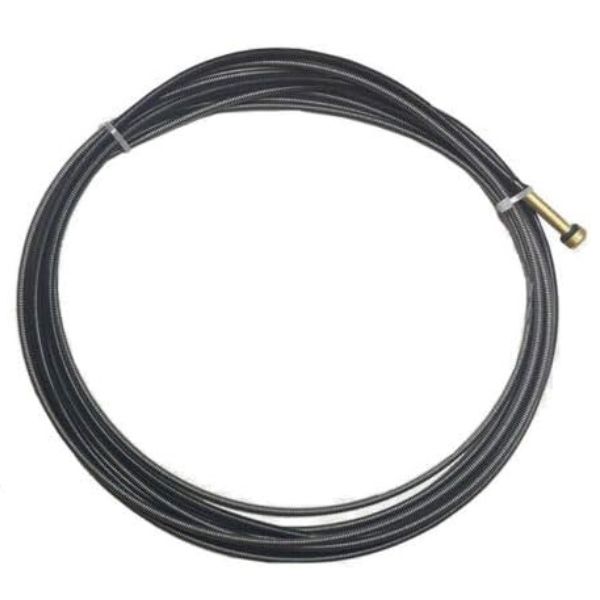
From K530-1 to K530-6 models, the Lincoln mig torch liner is compatible with all to fill your needs. Coming in a size of around 15ft, it is going to match various types of MIG guns with different sizes, including 12ft, 10ft, and 15ft guns.
No matter which diameter you want to use, this super-effective liner can feed the majority of wire sizes such as 0.023”, 0.025”, 0.024”, 0.035”, and 0.030”.
And guess what?
Lincoln Mig Gun Liner is capable of feeding both flux-cored wire and solid wires. So, it’s good to have such a welder liner to take your welding experience to a new height.
Its shipping policy is customer friendly if you buy from amazon. Also it provides warranties for damaged products.
Good Sides
- The 15ft liner matches several-sized guns
- Able to feed different sizes of wires
- Compatible with flux-cored and solid wires
Downsides
- Not the best choice for aluminum wires as aluminum is softer wire
#2. Welding City Steel Liner 35-40-15 (Best Steel Liner)
So, do you prefer a MIG liner for stainless steel wire? You may prefer stainless steel wire liners as they are corrosion free in nature.
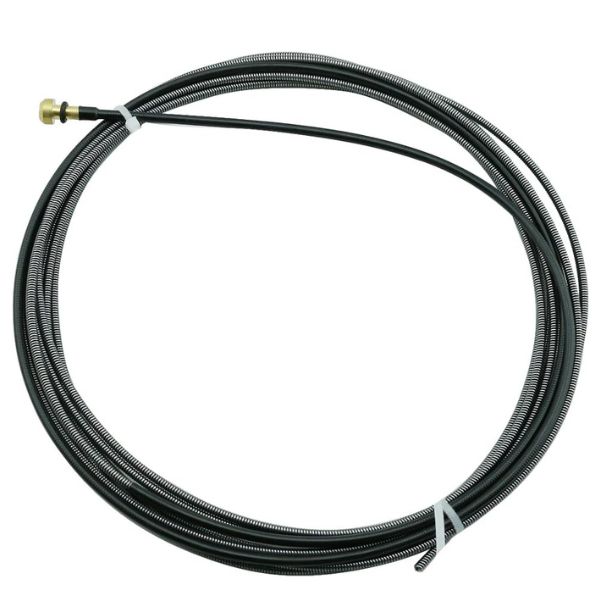
I’d strongly recommend giving the Welding City Steel Liner a try for stainless steel. This United States based product comes in top-notch quality. It also features “Tweco style” that makes it unique.
Like my previous choice, this one is also 15ft long to match numerous diameter wires, from 10ft. to 15ft. MIG guns. Alongside that, Welding City Liner matches hard alloy and stainless steel wires, making it a versatile liner among thousands of products around the world.
Lastly, I’ve found this one less expensive than the previous model. If you buy from amazon, you get an easy shipping policy and warranty for the product.
Good Sides
- Top-quality & Tweco style
- Supports both hard alloy and steel wires
- 15ft long liner and suitable for different diameter wires
Downsides
- Tightening is a bit challenging at times
#3. Miller Welding Cable Liner (Best Liner For Beginners)
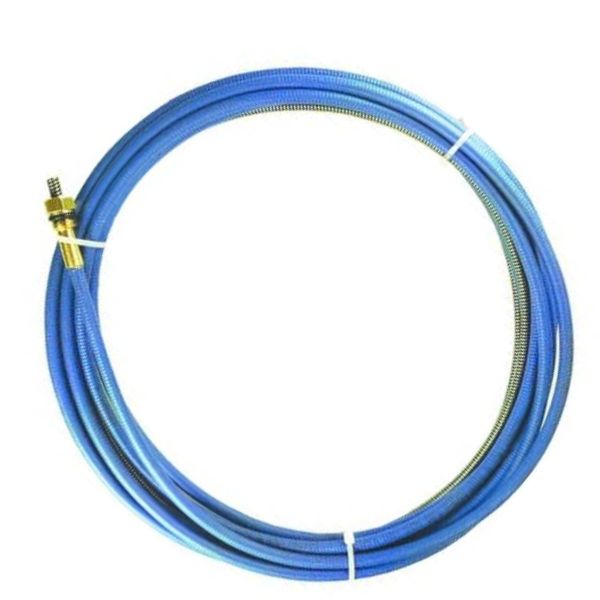
On list number 3, I’ve got the Miller Liner designed for the Millermatic series of mig gun. With a 15 ft. long liner, you’re allowed to use it on a couple of different mig guns like 15ft, 12ft, or even 10ft guns.
The liner can feed various diameter wire sizes, from 0.030” to 0.035”, thanks to its efficient size. Although it suits almost every Millermatic gun, you shouldn’t pick this up for miller cricket models. Because it won’t fit perfectly causing premature wire wear off or friction inside the gun.
What’s more?
Let’s talk about its installation. Trust me; you’ll find it way easier than your typical welder liner. And the price seems to be affordable too, making it both beginner-friendly as well as budget-friendly.
If you buy from amazon, they guarantee the delivery times lower than usual and also have a warranty for the product. Shipping facilities are also favorable.
Good Sides
- Matches different MIG guns
- Friendly with 0.030” to 0.035” diameter wires
- Affordable and relatively easy to install
Downside
- Doesn’t match miller cricket gun
#4. Hobart 196139 Liner (Best Liner For Longevity)

You must get yourself acquainted with the Hobart 196139 mig torch liner. Easy installation, ideal length & optimal longevity makes it one of the best liners for mig welding guns. This one can easily match any wire diameters ranging from 0.023” to 0.035″.
If you find it too long for your welding gun, feel free to cut the extra length part of it. And the best part is its suitability for both flux-cored wire, alloy steel, and stainless steel wires.
Good Sides
- Versatile and very easy to setup
- Easily fits 0.023” to 0.035” diameter wires
- Way long-lasting than the traditional liners
Downsides
- Will cost you a pretty penny
#5. Tweco 1420-1113 Conduit Liner (Best Universal Liner)
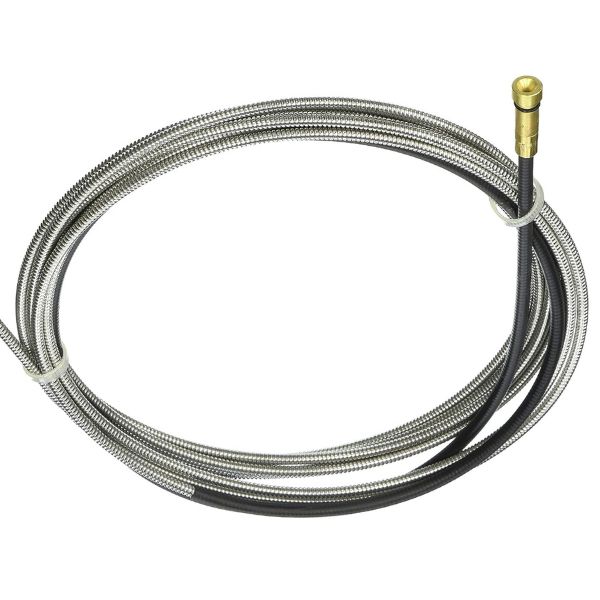
Here, I’m going to wrap up the list with a universal welder liner from the Tweco brand. I don’t know whether the brand name is familiar to you or not. But if you try this particular liner, you’ll love it as it is ideal for almost every MIG gun brand.
This “ready-to-use” conduit liner ensures hassle-free installation. Besides, it’s 15ft. universal length makes it a nice option for 0.030” to0 .035” diameter wire.
Good Sides
- The liner fits various Mig gun brands
- Reduces corrosion thanks to its spring wire (zinc-plated)
- Best for 0.030” to 0.035” MIG wire
Downside
- Might be a bit costly
Why is Mig Welder Liner Important?
Hands down, the MIG wire liner is as essential as basic parts of the MIG welder. It plays a significant role in guiding the wire from the feeder via gun cable to the contact tip. And the contact tip is the part of the mig gun that comes to direct contact with the base metal and work piece.
So if your MIG liner performs poorly, then the gun will eventually turn valueless and produce the worst results. That’s why it is considered a vital part of a mig welding machine.
What To Consider Before Buying Mig Liner (Buying Guide)
When purchasing a MIG gun liner, several factors should be considered to ensure you choose the right liner. Here’s are the factors-
Compatibility
Ensure that the MIG gun liner is compatible with your specific mig gun model. Different manufacturers and models may have variations in liner specifications.
Also verify that the liner is suitable for the diameter of the welding wire you intend to use. The liner should match the wire size recommended for your welding application.
a) Material
MIG gun liners are commonly made from materials like steel or plastics. Ensure the material’s durability especially if you expect to do heavy duty work with abrasive materials.
b) Liner Types
In general, there are several types of liners available around the world. That said, when it comes to the best performance, these are my favorite 3 to go for.
1. Steel Liners for MIG Gun
Steel liners tend to be more rigid, cost-effective, and flexible. Seasoned welders rely on it quite often as they suit mild steel most, including ER70S-6, ER70S-3, and so on.
Generally, a steel liner is abrasive on silicon bronze, aluminum, and such soft wires. Either go for a normal steel liner or the insulated one, depending on your needs and requirements.
2. Plastic Liners for MIG Gun
Apart from the cost-effective “steel liners,” there are also a couple of plastic liners available for your Mig gun. Although every type of plastic liner looks almost alike, they must still be ideal for different projects.
Following are some plastic liners-
- PTFE (Teflon)
- PA (Polyamide)
- C-PTFE (Carbon Teflon)
- PTFE High-Density (Teflon)
3. Jump Liners for MIG Gun (Neck Liners)
Do you want to enhance your wire liner’s lifespan?
If so, then neck liners are what you might be searching for. They are basically tiny liners with a short collet, which stands in the welding torch.
Using such a liner is convenient, time-saving, as well as cost-saving. And needless to say, it is more ecological than the typical ones.
c) Flexibility
The flexibility of the MIG gun liner is crucial for smooth wire feeding and preventing kinks or bends. A flexible liner is particularly important when working with intricate or tight welding applications.
d) Abrasion Resistance
Consider the liner’s resistance to abrasion, especially if you engage in heavy-duty welding or work with materials that can accelerate wear.
e) Temperature Resistance
Confirm that the liner is temperature resistant. The liner should withstand the heat generated during welding without deforming or compromising its structural integrity.
f) Ease of Installation and Replacement
Choose a MIG gun liner that is easily replaceable. A liner that facilitates straightforward maintenance can save time and effort during routine troubleshooting.
g) Brand Reputation and Quality
Consider the reputation of the brand. Good brands with a track record of producing high-quality welding consumables are more likely to provide reliable and durable MIG gun liners.
h) Cost
Though cost is an important factor, do not compromise the quality of liner. Good things often cost higher than usual. Investing in a high-quality MIG gun liner may initially cost more but can lead to better performance and longevity, ultimately saving you money in the long run.
So go for the best product instead of trying to save money buying a low quality product.
i) User Reviews and Recommendations:
Before buying, always check actual user reviews and seek recommendations from experienced welders.
Mig Welding Liner Problems and How to Solve?
You may notice 2 significant problems in your Mig liner from time to time. And to help you get rid of them, let me show you some of their causes and how to solve them:
1. Problem-1: Erratic Wire Feeding
Such a problem occurs if the liner turns worn out in some specific spots. Moreover, too much dust build-up and improper wire trimming during replacement may also be the common reason behind it.
Solutions:
- You’ll need to change/replace the completely worn-out liner.
- Ensure to trim the liner in an accurate way. That mustn’t be too short or too long.
2. Problem-2: Loose Cable Connection
Note that extreme heat build-up and discolored liner are the two common symptoms of electrical short. It happens because of too much loss of electricity at the arc.
Solutions:
- If the cable gets too discolored due to extreme heat build-up, you’ll need to replace it with a new one.
How to Change Liner and Install New One
Changing liner isn’t rocket science. You only need to follow some few steps to do that, and these are :
- Unscrewing the nut on the gun is what you need to do first.
- Pull out the liner right away from your Mig gun. While doing this, there is no need to provide excess pressure out there.
- Let’s feed the cleaned/newer liner to your MIG gun. Make sure the gun is in a straight direction.
- Push that liner slowly and as gently as possible. Don’t Rush at all. Now, make a connection between the liner and holding nut and Voila. It’s done.
What Mig Liner To Use for Aluminum Welding
When it comes down to welding aluminum, Teflon stands out as its soft material is highly capable of reducing feed and, at the same time, scratching or scoring wire of the aluminum.
On top of that, it is suitable for high heat projects, which generally use torches (water-cooled) and brass jump liners. Compared to polyethylene, it includes relatively more melting temperature to get your work done.
Talking about the size, it is available in a couple of different choices out there. And the good thing is that a short-sized 3M Teflon MIG Liner is enough for 1 mm to 1.2 mm aluminum wire.
What Mig Liner To Use for Stainless Steel Welding
Indeed, the majority of standard stainless steel wire suits steel liners. Unlike the mainstream liners, they are comparatively more resistant. Plus, they appear to be more abrasive on some of the softer-type wires, such as silicon- bronze, aluminum, cored wire, etc.
Are MIG Gun Liners Universal?
Although welding guns come in different specs and functionalities, MIG gun liners are usually made in a general size to match every gun perfectly.
From the length to the wire’s diameter, everything will appear to be same. But mig liners are not universal.
How to Clean Liner?
Here are the 3 easiest steps for cleaning liner:
- Step-1: Unfastening Liner Nuts: For this step, get yourself a spanner for unfastening liner nuts. Thus, you’re allowed to remove it from the Mig gun you use.
- Step-2: Blowing Out the Liner Right Away: Get your hands on a piece of compressed air can or something like that to blow it straight away in bursts via the dirty existing liner. This way, you can cast metal powders away and keep that stuff in a “spick-and-span” condition.
- Step-3: Observing the Liner: Let’s notice the liner for kinks when you clean that. Find out whether the weld begins to get too much drag or not. If everything seems okay, then congrats as you’ve cleaned up the liner.
Final Words
The comprehensive guide on MIG welder liner shows you almost all the nooks and crannies you’re searching for to get the most out of it. Plus, I’ve shared my ultimate choices on welder liners.
And depending on your needs and budget, any of them can be your go-to for upcoming projects.
